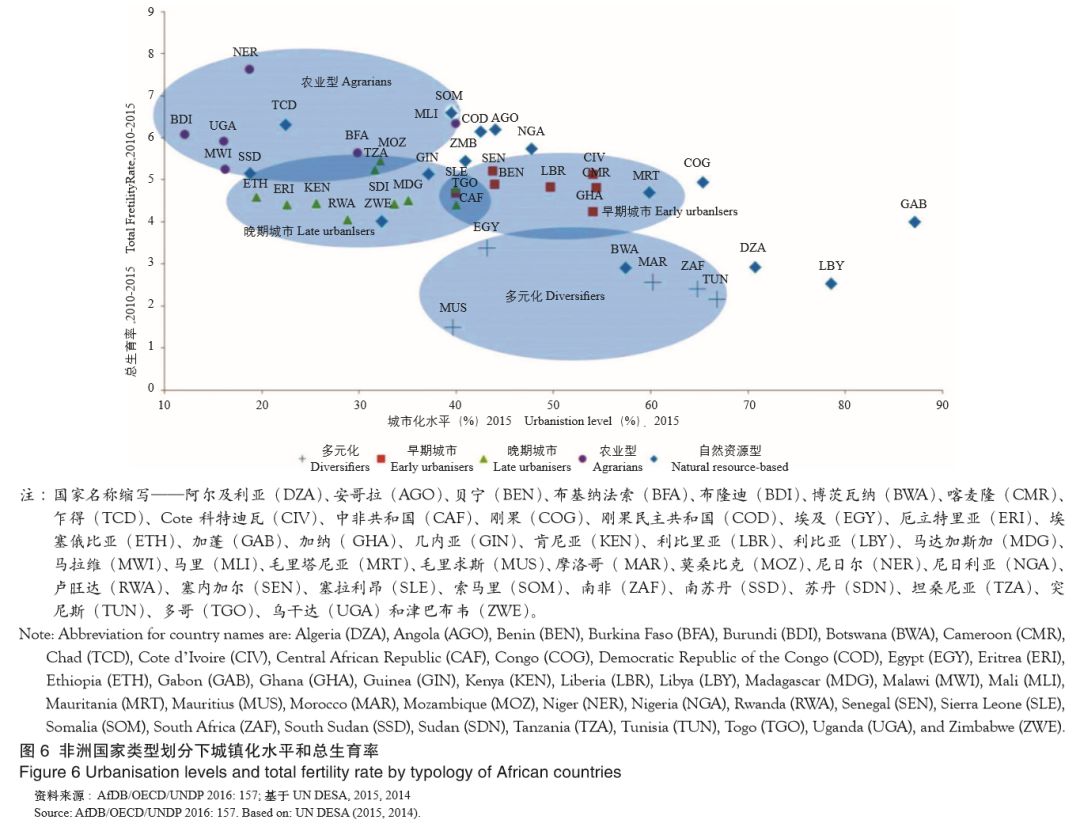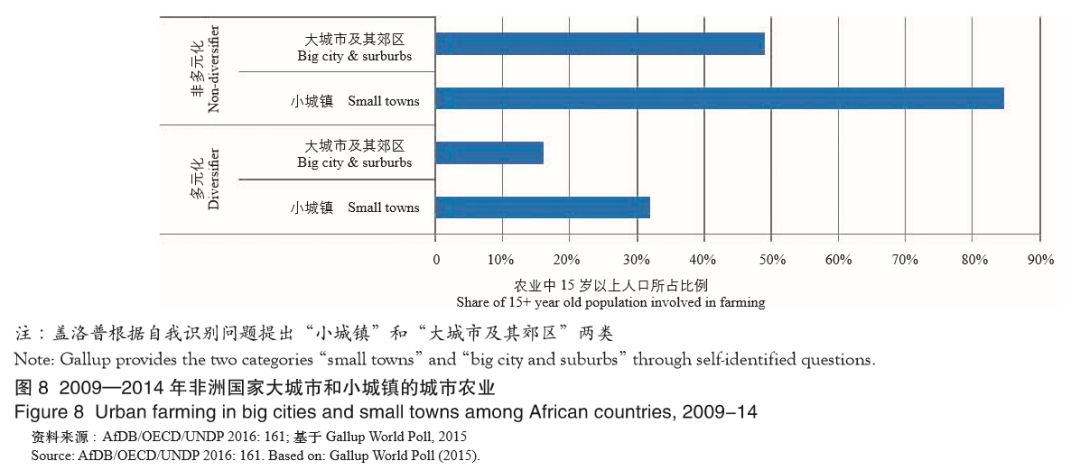
考研英语(二) 考研英语二(词汇) 考研英语二(语法长难句) 考研英语二(阅读、新题型) 考研英语二(翻译) 考研英语二(写作) 考研英语二(真题解析) 管理类综合 管理类综合(数学基础) 管理类综合(导学) 管理类综合(逻辑) 管理类综合(写作) 管理类综合(真题解析) 考研政治 考研政治(马原) 考研政治(史纲) 考研政治(毛中特) 考研政治(当代时政) 考研政治(真题解析) 考研英语(一) 复习指导 考研英语一(语法长难句) 考研英语一(词汇) 考研英语一(阅读、新题型) 考研英语一(完型填空) 考研英语一(翻译) 考研英语一(写作) 考研英语一(真题解析) 经济类综合 经济类综合(导学) 经济类综合(微积分) 经济类综合(线性代数) 经济类综合(概率论) 经济类综合(逻辑) 经济类综合(写作) 经济类综合(真题解析)
同等学力申硕 政策法规 报名考试 直播动态 同硕中国 江西同等学力申硕 广东同等学力申硕 安徽同等学力申硕 福建同等学力申硕 河南同等学力申硕 山东同等学力申硕 陕西同等学力申硕 辽宁同等学力申硕 湖北同等学力申硕 湖南同等学力申硕 河北同等学力申硕 北京同等学力申硕 浙江同等学力申硕 黑龙江同等学力申硕 重庆同等学力申硕 四川同等学力申硕 山西同等学力申硕 广西同等学力申硕 江苏同等学力申硕
2.2
五个主要国家群体可以说明非洲的城市和生育率转变,经济转型和中阶城市增长的多种模式
为了解各种城镇化模式,《 非洲经济展望 2016 :可持续城市和结构转型》根据非洲国家在三个进程结构转型——经济转型、城镇化、生育率转变——中所处的不同阶段,将其分为五类(图6 ;AfDB/OECD/UNDP 2016: 181-2)。 以概要的形式,可以通过以下方式来理解发展 :随着收入水平的提高,农村劳动力可以到他们愿意去的工厂工作并且减少生育。人均国内生产总值较高的国家往往表现出更高水平的制造业增加值,城市居民占总人口比例的大多数,而且生育率较低。但是,这种趋势的临界值在全球范围内有很大差异。通过分析55个非洲国家在这三个相关联方面相互作用的大小,形成5个主要国家群体(AfDB/OECD/UNDP 2016, 第 6—8 章), 这样可以更好地把握非洲国家的多样性。在每个群体中,政府都可以借助中阶城市来加速结构转型。

“
处于多元化城市国家群是在三个进程中处于最先 进阶段的五个非洲国家。城镇化水平在40%~67% 之 间。同时也已基本完成生育转变,总生育率约为每个妇 女有三个或以下的孩子。这些国家是埃及、毛里求斯、摩洛哥、南非和突尼斯。该群体拥有非洲最高的收入水 平(除摩洛哥外,2013年人均国民总收入超过1万美元)和人类发展水平(人类发展指数 [HDI]值超过0.60)。农业占国内生产总值(GDP)不到16%,制造业占GDP的 13%~18%。这些国家面临的主要挑战是提高生产力和经济复合性,因为他们的工业还没能转变 为精细化的制造业。事实上,在1980 年代末和1990 年代,该群体中的五个国家的制造业在 GDP 中的占比达到了其峰值,但此后一直下降。一些国家已经基本脱离工业化,例如,南非的制造业劳动者从1981年占总就业人数的17%缩减至2011年的12%,脱离制造 业的劳动者转向了服务业 ;其制造业规模也从1990年的24%下降到2014年的13%。
”
( AfDB/OECD/UNDP 2016: 155-7)
这些城镇化国家可以利用良好的中阶城市集群将地方经济与区域和全球价值链连接起来。一些国家已经尝试将某些中阶城市专门用于具体的经济活动。
摩洛哥的丹吉尔设置了汽车和物流部门,而马拉喀什、非斯和其他沿海城市则凭借其海上度假胜地、文化遗产的发展以及文化活动的组织吸引了旅游活动(如马拉喀什电影节)。前帝国首都梅克内斯凭借其历史遗产,成为大学城和旅游中心。
在南非,开普敦成为新技术和绿色经济创业公司 的中心,并且凭借其世界一流的大学、制酒企业和独特 的自然景观吸引了很多游客。
“
处于早期城市国家群的七个国家是在其城镇化和生 育转变方面取得进展但没有实现经济基础多元化的国家。 这些国家主要在西非,包括科特迪瓦、加纳和塞内加尔。 其城镇化率约为 35%~50%,总生育率约为每个女性有五 个孩子。它们通常是低收入至中低收入国家(2013年人 均国民总收入1000~4000 美元), 低等至中等水平人类 发展水平(人类发展指数为0.40~0.57之间)。 从1960— 2010年,移民和自然人口增长皆推动了其城市增长,从 农业向其他产业转移的移民使得劳动力转向城市地区。 然而,制造业规模仍较小,占 GDP的 2%~14%,而且很难消化占有很高比例的无技能劳动力。非正式服务部门 有了明显增长。这些早期城市国家群的国家面临的共同 挑战是有所突破进行更高价值的活动,特别是在城市正 规部门。这些国家应把重点放在发展能够吸纳低技能劳动力的制造业上,制定长远的教育政策,发展更高附加 值的城市服务,进一步提高农业生产力以及持续人口转型。
”
( AfDB/OECD/UNDP 2016: 155-7)
有针对性地支持中阶城市创业和商业发展可以促进其商业集群发展,特别是通过改善基础设施联系,简化商业登记程序,提供有针对性的培训以获得高质量的技能以 及财务支持。在加纳,库马西市的 Suame Magazine 的非正 式集群很好地例证了一个中阶城市如何促进小型制造业基 地的发展,哪怕是以非正式的方式。
西非国家还开展了中阶城市的跨国合作,例如锡卡索(马里)、 科霍戈(科特迪瓦)和博博迪乌拉索(布基纳法索)之间的SKBo计划。 SKBo推动了农业和非农业 活动的贸易发展以及这些城市之间的文化活动。
“
晚期城市国家群是以农村为主的八个国家,但最近开始了城镇化、生育转变以及经济转型。这些国家位 于东非,包括埃塞俄比亚、肯尼亚和坦桑尼亚。有不到1/3的人口居住在城市地区,总生育率为每个妇女有4~6个孩子。收入水平较低(2013年人均国民总收入为1000~3500美元), 人类发展水平是低到中等(人类发展指数在0.38~0.54之间)。 制造业占GDP的比例不足4%~12%。虽然从低水平起步,但是埃塞俄比亚和卢旺达 等几个国家在过去10年中积极转变了其经济结构。晚期 城市国家群面临的主要挑战是 :继续改善基础设施,尤其是联系中阶城市和其他城市发展中心的交通运输,在不断走出农业、走向城镇化和加速人口转型的同时,实现突破,进入制造业和有更高价值的服务业。
这些国家可以发展一个中阶城市网络来支持如今 快速进行的城镇化。要达到这一点,需要投资信息系 统制定长期战略,根据新定居的城镇化人口的需要来 发展基础设施(如道路等),明确土地所有权以吸引投资、使地方政府便于通过土地收入机制来更好地利用 当地资源。目前,埃塞俄比亚和卢旺达正在实施这种 战略,后文将说明。
农业型国家群是9个以农村为主的国家,仍处于 城镇化和生育转型的初期阶段。许多农业型国家都是内陆国,如乍得、尼日尔和马拉维。通常不到三分之一的人口居住在城市地区,平均每个妇女至少有6 个 孩子。2013 年这些国家的人均收入水平未超过人均国民总收入1 900 美元,人类发展水平很低(人类发展 指数在0.48~0.34 之间)。其经济以农业为主 :农业占 国内生产总值的 25%~58%,制造业占 4%~12%。对于这些国家来说,自然人口增长推动了 2000—2010 年间 的城市人口增长。尽管城乡迁移会随着城市转型的开 始而增加,但是其经济发展还不足以吸引更多的农村 人口向城市地区迁移。农业型国家所面临的挑战,是要通过提高农业生产力并参与经过周密规划的城镇化进程,更坚定地开始结构转型进程。一旦这些国家加速结构转型,其生育转型也很可能开始。
专用政策可以帮助中阶城市为农村经济创造食品 和其他商品的需求发挥重要作用,从而促进农业生产 力持续增长。
以自然资源为基础的国家从自然资源利用中获得 了丰厚的收入,并且使劳动力摆脱了农业。与其他同 等收入水平的国家相比,这13 个国家的城镇化程度更高(40%~78%), 并且生育率也更高,城市占高度主导地位,其首都通常比其他城市大得多。农业在GDP中的占比很低,为 3%~21%。这些国家在收入水平(人 均 500~20 000 美元)、 生产的自然资源类型(例如碳氢化合物、矿物和金属)及地理特性(例如利比亚主要为干旱,而尼日利亚多依靠雨水)上有很大的差异。 这些国家面临的共同挑战是利用其在国际贸易中的竞争优势使经济基础多元化,摆脱自然资源依赖,特别是降低城市地区生育率。但是,他们目前需要具体的政策来应对全球商品价格下跌的不利局面。
”
( AfDB/OECD/UNDP 2016: 155-7)
这些国家可以借助中阶城市来实现经济多元化, 为当地消费者开发本地产品而不是进口商品。中阶城市可以在发展食品经济、服务和低技能制造业的基础需求方面发挥关键作用。
该聚类分析表明,在经济尚未多元化的国家中,中阶城市和城乡结合部的增长尤为突出(图 7)。 在较单 一的经济体中,小城镇和中阶城市会在结构转型中能否 实现可持续发展目标方面发挥重要作用。


例如
在后期城市和农业型国家群,城乡结合部吸纳了 90% 以上的总人口增长。
在自然资源型国家群,中阶城市定义为居民少于 50 万人的城市地区,它们吸纳了 40% 的总人口增长。 这种类型划分还表明,与多元化经济国家相比,非 多元化国家中城乡生活方式的差异更加模糊。来自盖 洛普的现有数据表明,在没有实现经济多元化的国家中,小城镇中的城市农业比在多元化国家中更为普遍。 “2009—2013年期间,非多元化非洲国家的城镇中15岁以上的居民中有 85% 参与农业,大城市及其郊区的这一比例为 49%。而在非洲多元化国家,这一比例在城镇中为 32%,在大城市和郊区中为 16%”(AfDB / OECD / UNDP 2016: 161)。发展有效的城乡经济联系有助于提高 农业生产力,对实现可持续发展目标至关重要。
2.2
Five main country groups can explain the diverse patterns of urban and fertility transition, economic transformation, and intermediary cities growth in Africa
To understand the wide variety of urbanisation patterns, the African Economic Outlook 2016: Sustainable Cities and Structural Transformation grouped African countries into five types according to their stages in three processes of structural transformation: economic transformation, urbanisation, fertility transition (Figure 6; AfDB/ OECD/UNDP 2016: 181-2). In a schematic way, development can be understood in the following way: as income levels rise, rural workers move to cities where they tend to work in factories and make less children. Countries with higher GDP per capita tend to show a higher level of manufacturing value-added in GDP, have a majority of urban residents as a share of the total population, and lower fertility ratios. However, thresholds for these trends can vary a lot at the global level. The diversity of African countries can be better understood by analysing how these three inter-related dimensions interact for the 55 African countries, resulting in 5 main clusters of countries (AfDB/OECD/ UNDP 2016, chapters 6, 7 and 8). In each cluster, governments can use intermediary cities to accelerate structural transformation.

“
The diversifiers are the five African countries at the most advanced stage of the three processes. Their urbanisation levels range between 40% and 67%. They are also close to completing their fertility transition with total fertility ratios of about three or fewer children per woman. These countries are Egypt, Mauritius, Morocco, South Africa and Tunisia. This group has Africa’s highest level of income (above USD 10 000 gross national income [GNI] per capita in 2013 with the exception of Morocco) and of human development (with a Human Development Index [HDI] value above 0.60). Agriculture generates less than 16% of gross domestic product (GDP) and manufacturing 13-18% of GDP. The main challenge for these countries is to increase both productivity and economic complexity, as they have not yet been able to transition to sophisticated manufacturing. Indeed, the share of manufacturing in GDP peaked for all five countries in the diversifiers’ group during the late 1980s and the 1990s and has since declined. Several countries have de-industrialised significantly. For example, South Africa’s manufacturing workforce has shrunk from 17% of total employment in 1981 to 12% in 2011, shifting towards services; the size of its manufacturing sector decreased from 24% in 1990 to 13% of GDP in 2014.
”
( AfDB/OECD/UNDP 2016: 155-7)
These urbanised countries can use intermediary cities as clusters of excellence to connect local economies to regional and global value chains. Several countries have already attempted to specialise certain intermediary cities into specific economic activities.
In Morocco, Tangiers developed the automotive and logistics sector, while Marakech, Fez and other cities located on the sea side attracted touristic activities owing to the development of sea resorts, cultural heritage, and through the organisation of cultural activities (such as the Marakech film festival). The former imperial capital Meknes developed as university town and tourist centre thanks to its heritage.
In South Africa, Cape Town developed as a hub for new startups in new technologies and green economy and attracted tourists thanks to its world class university, wine-making businesses and unique natural site.
“
The early urbanisers are seven countries that have progressed in their urban and fertility transition without having been able to diversify their economic base. Mostly found in West Africa, they include Côte d’Ivoire, Ghana and Senegal. These countries are about 35%~50% urbanised and have total fertility ratios of about five children per woman. They are typically low- to lower-middle income countries (USD 1 000-4 000 GNI per capita in 2013), with low-tomedium levels of human development (HDI values between 0.40 and 0.57). Between 1960 and 2010, both migration and natural population increase have driven their urban growth. Migration out of agriculture has pushed the labour force to urban areas. Yet the manufacturing sector remains small, 2%~14% of GDP, and can hardly absorb the high proportion of unskilled labour. The urban informal services sector has grown significantly. The common challenge for these early urbanisers is to break into higher value activities particularly in the urban formal sector. These countries should focus on manufacturing that can absorb a low-skilled labour force, pursue ambitious education policies, develop higher valueadded urban services, further raise agricultural productivity and continue their demographic transition
”
( AfDB/OECD/UNDP 2016: 155-7)
Targeted support to entrepreneurship and business development in intermediary cities can help grow business clusters therein, notably by improving infrastructure linkages, easing business registration procedures, offering targeted training to gain quality skills, and financial support. In Ghana, the informal cluster of Suame Magazine in the city of Kumasi is a good example of how an intermediary city can develop a small manufacturing base, even informally (see above).
Countries in West Africa have also developed transnational cooperation between intermediary cities, such as SKBo programme between Sikasso (Mali), Korhogo (Côte d’Ivoire), and Bobo-Dioulasso (Burkina Faso). SKBo promotes the development of trade in farming and non-farm activities, and cultural activities between these cities.
“
The late urbanisers are eight countries that are predominantly rural yet have begun their urban and fertility transition and economic transformation more recently. They are located in East Africa and include Ethiopia, Kenya and Tanzania. Less than a third of their population typically lives in urban areas. Their total fertility rates are four to six children per woman. Income levels are low (USD 1 000~3 500 GNI per capita in 2013). Human development levels are low-to-medium (HDI values between 0.38 and 0.54). Manufacturing makes up less than 4%~12% of GDP. While starting from a low base, several countries including Ethiopia and Rwanda have positively transformed their economic structures within the past ten years. The main challenges for the late urbanisers are: continue to improve their infrastructures, particularly transportation linking intermediary cities and different urban growth centres, break into manufacturing and higher value services as they continue to move out of agriculture, urbanise, and accelerate their demographic transition.
Dedicated policies can help their intermediary cities play an important role in creating the demand for food and other goods produced in their rural economies, so that farming productivity continues to grow.
The natural resources-based countries have urbanised with windfalls from natural resources, which have attracted labour out of agriculture. Compared with other countries at similar income levels, these 13 countries show a higher degree of urbanisation (40%~78%), generally higher fertility rates and a high degree of urban primacy with the capital usually disproportionally bigger than other cities. The share of GDP in agriculture is low at 3%~21%. These countries exhibit huge variations in income levels (USD 500~20 000 per capita), in the types of natural resources they produce (e.g. hydrocarbons, minerals and metals) and in their geography (e.g. Libya is predominantly arid while Nigeria is mostly rain-fed). Their common challenges are to use their competitive advantage in international trade to diversify their economic base away from natural resources and to decrease fertility particularly in urban areas. However, they currently need specific policies to face the adverse global conditions of lower commodity prices.
”
( AfDB/OECD/UNDP 2016: 155-7)
These countries can use intermediary cities to diversify their economies and develop local products for local consumers instead of importing them. Intermediary cities can play a crucial role in developing a demand base for the food economy, services, and low-skills manufacturing.
This cluster analysis shows that the growth intermediary cities and of the rural urban interface is particularly striking in the countries whose economies have not yet diversified (Figure 7). It is in these less diversified economies that small towns and intermediary cities will play an essential role in structural transformation, to achieve or miss the SDGs.


For instance
In the late urbanisers and agrarian countries, the rural urban interface has absorbed over 90% of total population growth.
In natural resource-based countries, intermediary cities defined as urban areas with less than 500 000 inhabitants have absorbed 40% of total population growth.
This typology also shows that the differences in lifestyle between rural and urban areas are more blur in the non-diversifier countries compared to the diversified economies. Available data from Gallup shows that urban farming is more prevalent in the small towns of countries that have not diversified their economies than in the diversifier countries. “For the period 2009-13, 85% of dwellers aged 15 or older in the towns of non-diversifier African countries are involved in agriculture, while the share is 49% in big cities and suburbs. In Africa’s diversifier countries, the ratio stands at 32% in towns and 16% in big cities and suburbs.”
(AfDB/OECD/UNDP 2016: 161). Developing effective linkages between urban and rural economies will help increase farming productivity, which is crucial to achieve the SDGs.
03
中阶城市面临的巨大挑战阻碍其实现可持续发展目标的潜力
然而,中阶城市潜力的发挥受到重重阻碍。这些挑战主要与缺乏就业机会、贫民窟城镇化、社会包容性差、 环境退化和缺乏生产力尤其是财政资源有关。
03
Intermediary cities face big challenges hindering their potential to achieve the SDGs
However, the potential of intermediary cities is hindered by big challenges. These challenges pertain notably to lack of jobs creation, slums urbanisation, social inclusion, environmental degradation and lack of capacity particularly financial resources.
3.1
缺乏正式的就业机会是非洲城镇化的主要挑战
缓慢经济转型的城镇化带来的后果是非洲城市面临 的最大挑战仍然是提供就业机会,特别是在快速发展的城 镇和中阶城市中。大多数城市劳动者从事非正式工作,如 生产率低的零售服务。非正式工作仍是大多数非洲国家的 特点,虽然没有最新的数据,但现有数据显示非正式经济 约占城市就业的61%,提供新就业机会的93%(Kessides, 2005)。 对非洲妇女而言,非正式经济大约占除农业外 所有就业机会的92%,绝大多数为个体经营或自营工作 (ILO, 2002; Kessides, 2005)。 在科特迪瓦的几个中阶城市, 非正式部门占总就业人数的85%以上。
正如对盖洛普数据的分析①(图 9),非正式就业在中阶城市和城镇中极其普遍。
① 盖洛普的调查只区分了“小城镇”和“大城市和郊区”。鉴于非洲数据稀缺,我们在这里使用“大城市及其郊区”指代“主要城市”,用“小城镇” 指代“中等城镇”

平均来看,在非洲的小城镇中,只有25% 的劳动 力可能会有全职带薪的工作,而大城市则为 38%。
在非多元化国家,大城市和城镇的差距极其明显 : 在其城镇中,只有16% 的在职人口拥有全职工作,而大 城市及其郊区为 28%。相比之下,在多元化国家,大城市 和城镇之间的差距仅为 4%。
相对而言,城镇人口的个体经营和兼职工作比例高 于大城市。在非多元化国家的城镇中,有一半的受访者 要么是个体经营,要么是兼职工作(AfDB/OECD/UNDP 2016: 163)
这种情况的直接影响是城市增长过快,超过了城市可以提供生产性经济机会和服务的能力。这导致城市地区的密度降低,从而减少了在“电梯城市”中实现与更高密度和建筑高度相关的规模经济的潜力。在许多中阶城市中, 城市扩张呈现碎片化态势,新的发展从中部核心向低密度地区飞跃(Angel et al, 2010a)。 因此非洲城市面临城市蔓延的威胁,其与市场、供应商、消费者和理念相互连通而带来的益处也下降了(AfDB/OECD/UNDP, 2016: 174)。 表 3 表明,从1990年代以来,埃塞俄比亚的四个中阶城市(默克莱、阿达玛、哈瓦萨、巴赫达尔)的建成区面积增长速度是其人口的两倍。在同一时期城市用地面积扩大的情况下,人均城市面积的年增长率为 2%,这一趋势在许多非洲其他国家也是如此。将就业和公共产品带到人口密度低的地区是具有挑战性的。

3.1
Lack of formal job creation is the main challenge of Africa’s urbanisation
A consequence of urbanisation with slow economic transformation is that jobs creation remains African cities’ biggest challenge, particularly in the fast growing towns and intermediary cities. Most urban workers are trapped in informal activities, typically retail services with lowproductivity. Informal jobs remain a hallmark of most African countries. Although no up-to-date data exists, the informal economy is estimated at 61% of urban employment and 93% of all new jobs created (Kessides, 2005). For African women, the informal economy is estimated to represent 92% of all job opportunities outside of agriculture, overwhelmingly as self-employment or own-account work (ILO, 2002, quoted by Kessides, 2005). In several intermediary cities in Côte d’Ivoire, the informal sector makes over 85% of total employment.
Informality is particularly widespread in intermediary cities and towns, as shown by our analysis of Gallup data (Figure 9) ① :
① Gallup’s surveys only distinguish between “small towns” and “big cities and suburbs”. Given the data scarcity in the African context, we use here “big cities and suburbs” as a proxy for “primary cities” and “small towns” as a proxy for “intermediary cities, and towns”.

On average, in Africa’s small towns only 25% of the labour force is likely to have a full-time wage-paying job, compared to 38% in big cities.
This gap between big cities and towns is particularly acute in the non-diversifier countries: in the towns of non-diversifier countries, only 16% of the active population has a full-time job, compared to 28% in the big cities and suburbs. By contrast, in diversifier countries, the gap between big cities and towns is only 4% points.
In contrast, populations in towns have a higher share of selfemployment and part-time employment than populations in big cities. In towns among non-diversifier countries, half of respondents are either self-employed or in part-time employment (AfDB/OECD/ UNDP 2016: 163).
A direct implication is that rapid urban growth is outstripping the capacities of cities to provide productive economic opportunities and services. This leads to lower density in urban areas, reducing the potential to foster economies of scale that come with higher density and higher buildings in “elevator cities”. In many intermediary cities, urban expansion has been fragmented, with new development leapfrogging from the central cores to low density areas (Angel et al, 2010a). African cities thus suffer from the challenges of urban sprawl, decreasing the benefits of connectivity to markets, suppliers, customers and ideas (AfDB/OECD/UNDP, 2016: 174). Table 3 shows that in Ethiopia, the built-up area of four intermediary cities (Mekele, Adama, Hawasa, Bahir Dar), grew twice as fast as their population since 1990s. The urban areas per person grew at 2% per year during the same period urban land area expansion. This trend is similar in many other African countries. It is challenging to bring jobs and public goods to areas with low population density.

3.2
非洲城镇和中阶城市的增长速度超过其首位城市
这些经济挑战成为社会排斥和环境退化现象出现的原 因。由于城市贫困率居高不下,没有正常就业的城市引发了“贫民窟城镇化”, 在小城镇这种现象更为普遍。一个贫民窟家庭指在以下五个保障设施中至少缺失一项 :经久 的住房、足够的居住面积、经过处理的用水、已经改善 的卫生条件或土地保有权。到 2050 年,许多非洲国家 面临的真正风险是届时贫民窟人口将增加为现有的三倍 (AfDB/OECD/UNDP, 2016: 164)。 贫民窟城镇化大多出现在较小城市和中阶城市当中,穷人无法企及国家和地方政府或国际发展共同体。在莫桑比克等可获得数据的国家,分析得知非正式住区占用了二级城市90%的市政公共用地(UN-Habitat, 2015/16: 58)。
3.2
Lack of jobs and public goods leads to“ slums urbanisation”
These economic challenges spiral into social exclusion and environmental degradation. Cities without formal jobs give rise to “slums urbanisation” as the rate of urban poverty remains high, particularly in the small towns. A slum household is defined as deprived in at least one of the five following amenities: durable housing, sufficient living area, access to improved water, improved sanitation or secure tenure. Many African countries face a real risk of tripling their slum population by 2050 (AfDB/OECD/UNDP, 2016: 164). Slums urbanisation is happening to a great extent in smaller and intermediary cities, where poor people are beyond the reach of national and local governments or of the international development community. In countries for which data is available, such as Mozambique, informal settlements make up to 90% of municipal territory in secondary cities (UN-Habitat, 2015/16: 58).
3.3
中阶城市的地方政府没有足够的资源来应对这些挑战
中阶城市面临的经济、社会和环境挑战因城市资源 缺乏而加剧。非洲城市的投资需求每年约为300亿美元, 其中撒哈拉以南非洲地区为200亿美元(Paulais, 2012: 100)。对于中阶城市来说这一挑战尤为严峻,因为其资 源远少于首都和主要城市。根据现有数据,大多数中阶 城市的人均支出低于1美元,人均可支配收入不足4美元(图10),是欧洲国家可用金额的约1/1 000(AfDB/ OECD/UNDP, 2016)。 相比之下,非洲一些省会城市的人均可支配收入约为40 美元——尽管这些收入仍然很低,并不能够满足城市对基本服务的日益增长的需求。

3.3
Local governments in intermediary cities do not have adequate resources to tackle these challenges
Intermediary cities’ challenges economic, social and environmental challenges are compounded by cities’ lack of resources. African cities’ investment needs have been estimated at around USD 30 billion per year, of which USD 20 billion for sub-Saharan Africa (Paulais, 2012: 100). This challenge is particularly acute for intermediary cities, which have much less resources than capitals and primary cities. According to the available data, most intermediary cities have expenditure of less than USD 1 per capita and operating revenues of less than USD 4 per capita (Figure 10). This may be about 1,000 times the amounts available in European countries (AfDB/ OECD/UNDP, 2016). In comparison, some capital cities in Africa have operating revenues of about USD 40 per capita per year – although these revenues remain low and are insufficient to meet the growing urban demand for basic services.

© 2019-2021 All rights reserved. 北京转创国际管理咨询有限公司 京ICP备19055770号-1
Beijing TransVenture International Management Consulting Co., Ltd.
地址:佛山市金融高新区京华广场
北京市大兴区新源大街25号院恒大未来城7号楼1102室
深圳市福田区华能大厦
深圳市南山区高新科技园南区R2-B栋4楼12室
梅州市丰顺县留隍镇新兴路881号
汕头市金平区华坞村七巷三楼
长沙市芙蓉区韶山北路139号文化大厦

欢迎来到本网站,请问有什么可以帮您?
稍后再说 现在咨询